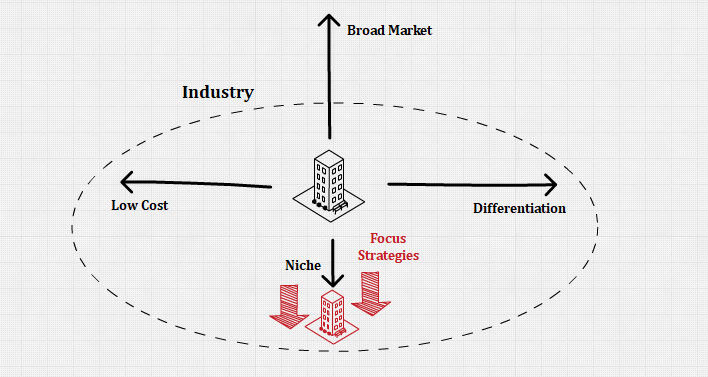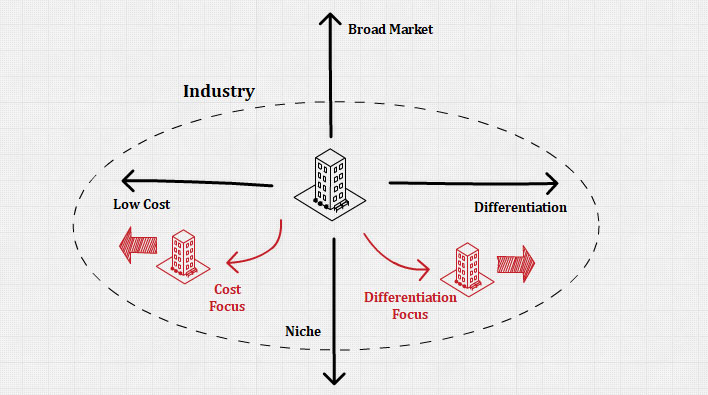Concept of Focus Strategies

Definition
A focus strategy is an integrated set of actions taken to produce products, goods, or services that serve the needs of a particular market segment, instead of a whole broad market.
Although the breadth of a target is clearly a matter of degree, the essence of the focus strategy is the exploitation of a narrow target’s differences from the balance of the industry.
Thus, firms are said to use a focus strategy when they utilize their core competencies to serve the needs of a particular market segment or niche to the exclusion of others.
A focus strategy concentrates on serving a particular market niche, which can be defined by (1) a different segment of a product line, (2) a different geographic market, or (3) a particular customer group.
There are many specific customer needs firms can serve by using this focus strategy. Selecting a niche by type of customer might mean serving only the very rich, the very young, or the very adventurous.
Examples of specific market segments that can be targeted by a focus strategy include (1) a particular buyer group, (2) a different segment of a product line, or (3) a different geographic market
Focus strategy differs from cost leadership strategy and differentiation strategy chiefly in that it is directed toward serving the needs of a limited customer group or segment.
As for customer groups, a focused company chooses specific niches or market segments in which to compete rather than going for a whole market, as a cost leader does, or filling a large number of niches, as a board differentiator does.
Reasons to Use This Strategy
One of the reasons for entrepreneurial firms to utilize focus strategy and thus serve a specific market niche or segment is partly because they do not have the knowledge or resources to serve the broader market.
Another reason for firms to utilize a focus strategy is that they generally prefer to operate below the radar of larger and more resource-rich firms that serve the broader market.
Objectives of This Strategy
Serve market more effectively: Firms using the focus strategy intend to serve a particular market segment more effectively than can industry-wide competitors.
Firms succeed when they effectively serve a segment whose unique needs are so specialized that broad-based competitors choose not to serve that segment or when they satisfy the needs of a segment being served poorly by industry-wide competitors.
Complete value chain activities competitively: Firms must be able to complete various primary value chain activities and support functions in a competitively superior manner to develop and sustain a competitive advantage and earn above-average returns.
Two Types of Focus Strategies

Firms can create value for customers in specific and unique market segments by using the focused cost leadership strategy or the focused differentiation strategy.
In essence, a focused company is a specialized differentiator or a cost leader. Thus, once a firm has chosen its market segment, it pursues a focus strategy through either differentiation or a low-cost approach.
The activities required to use the focused cost leadership strategy are virtually identical to those of the industry-wide cost leadership strategy, and activities required to use the focused differentiation strategy are largely identical to those of the industry-wide differentiation strategy.
The focused firm might find a cost advantage and develop superior efficiency in low-cost manufacturing within a region. Alternatively, it might develop superior skills in responsiveness to customers, based on its ability to serve the needs of regional customers in ways that a national differentiator would find very expensive.
The manner in which each of the two focus strategies allows a firm to deal successfully with the five competitive forces parallels those of the two broad strategies.
The competitive forces within a given industry often favor either cost leadership or a differentiation strategy.
The only difference between focused cost leadership and cost leadership, or focused differentiation and differentiation, is in the firm’s competitive scope. The firm naturally focuses on a narrow industry segment.
A focused company has an enormous opportunity to develop its own niche and compete against larger low-cost and differentiated companies. A focus strategy provides an opportunity for an entrepreneur to find and then take advantage of a gap in the market by developing an innovative product that customers cannot do without.
The Nature of the Focus Cost Leadership Strategy
Focused cost leadership is the first of two focus strategies.
A focused cost leadership strategy requires firms to compete based on price to target a narrow market.
The nature of the narrow target market varies across firms that use a focused cost leadership strategy. In some cases, the target market is defined by demographics. In other cases, the target market is defined by the sales channel used to reach customers.
Focused companies are likely to be able to differentiate their products successfully because of their detailed knowledge of a small customer set or of a region.
Furthermore, concentration on a small range of products sometimes allows a focuser to develop innovations faster than a large differentiator can.
A firm that follows this strategy does not necessarily charge the lowest prices in the industry. Instead, it charges low prices relative to other firms that compete within the target market.
Essentially, the firm competes against the cost leader in the market segments in which it has no cost disadvantage.
The focuser may also have a cost advantage because it is producing complex or custom-built products that do not lend themselves easily to economies of scale in production and, therefore, offer few experience-curve advantages.
Moreover, the company can concentrate on small-volume custom products for which it has a cost advantage, and leave the large-volume standardized market to the cost leader.
The Nature of the Focused Differentiation Strategy
Focused differentiation is the second of two focus strategies.
A focused differentiation strategy requires offering unique features that fulfill the demands of a narrow market.
If a company uses a focused differentiation approach, then all the means of differentiation that are open to the differentiator are available to the focused company.
However, the focused company only competes with the differentiator in one or a few market segments. The focuser does not attempt to serve all market segments, because doing so would bring it into direct competition with the differentiator.
Instead, a focused company concentrates on building market share in one or a few market segments and, if successful, may begin to serve more and more market segments and chip away at the differentiator’s competitive advantage over time.
The unique features provided by firms following a focused differentiation strategy are often specialized.
While a differentiation strategy involves offering unique features that appeal to a variety of customers, the need to satisfy the desires of a narrow market means that the pursuit of uniqueness is often taken to the proverbial next level by firms using a focused differentiation strategy.
By their nature, firms using a focused differentiation strategy concentrate their efforts on a particular sales channel, such as selling over the Internet only. Others may target particular demographic groups.
Advantages and Disadvantages of Focused Strategies

Advantages
High product or service prices: a firm with focus differentiation can charge very high prices. Indeed, these firms often price their wares far above what is charged by firms following a differentiation strategy.
High expertise: a firm using a focus strategy often can develop tremendous expertise about the goods and services that they offer. In markets such as camping equipment where product knowledge is important, rivals and new entrants may find it difficult to compete with firms following a focus strategy.
Customer intimacy: focus strategy permits a company to stay close to its customers and to respond to their changing needs.
Protection from competitive forces: the firm is protected from rivals to the extent that it can provide a good or service that it cannot. This ability also gives the focuser power over its buyers because they cannot get the same product from anyone else. Potential entrants have to overcome the customer loyalty the focuser has generated, which also reduces the threat from substitute products.
This protection from the five forces allows the focuser to earn above-average returns on its investment.
Disadvantages
Limited demands: a firm utilizing a focused differentiation strategy may have to face the limited demand available within the selected market segment or niche.
A firm could find its growth ambitions stymied. Once its target market is being well served, expansion to other markets might be the only way to expand, and this often requires developing a new set of skills.
Unstable niche: after firms pursuing the market segment or niche of their choices, the niche could then disappear or be taken over by larger competitors.
Competitors on the same segment: there is the prospect that differentiators will compete for a focuser’s niche by offering a product that can satisfy the demands of the focuser’s customers. A focuser is vulnerable to attack and, therefore, has to defend its niche constantly.
Competitors with narrower focus: damaging attacks to a focused differentiator may come not only from larger firms but also from smaller ones that adopt an even narrower focus on customer needs.
Competition from competitive forces: with regard to powerful suppliers, a focused company is at a disadvantage because it buys inputs in small volume and thus is in the suppliers’ power. However, as long as it can pass on price increases to loyal customers, this disadvantage may not be a significant problem.
Profitability is hard to maintain: because a focuser produces a small volume, its production costs often exceed those of a low-cost company. Higher costs can also reduce profitability if a focuser is forced to invest heavily in developing a distinctive competency, such as expensive product innovation, in order to compete with a differentiated firm.
However, flexible manufacturing systems are opening up new opportunities for focused firms because small production runs become possible at a lower cost.
Risks of Focus Strategies

With either focus strategy, the firm faces the same general risks as does the company using the cost leadership or the differentiation strategy on an industry-wide basis.
However, focus strategies have three additional risks.
First, a competitor may be able to focus on a more narrowly defined competitive segment and thereby out-focus the focuser.
Second, a company competing on an industry-wide basis may decide that the market segment served by the firm using a focus strategy is attractive and worthy of competitive pursuit.
The third risk involved with a focus strategy is that the needs of customers within a narrow competitive segment may become more similar to those of industry-wide customers as a whole over time. As a result, the advantages of a focus strategy are either reduced or eliminated.
Resources
Further Reading
- How To Create a Focus Strategy (indeed.com)
- Focus Strategy: Meaning, Types of Focus Strategy (iedunote.com)
- Focus Strategy (educba.com)
- Focus Strategy – Definition, Types & Examples (marketingtutor.net)
- Focus Strategy Advantages and Disadvantages (brandongagile.com)
Related Concepts
- Business-Level Competitive Strategies
- Cost Leadership Strategy
- Differentiation Strategy
- Integrated Best Cost Strategy
References
- Hill, C. W. L., & Jones, G. R. (2011). Essentials of Strategic Management (Available Titles CourseMate) (3rd ed.). Cengage Learning.
- Mastering Strategic Management. (2016, January 18). Open Textbooks for Hong Kong.
- Wheelen, T. L. (2021). Strategic Management and Business Policy: Toward Global Sustainability 13th (thirteenth) edition Text Only. Prentice Hall.